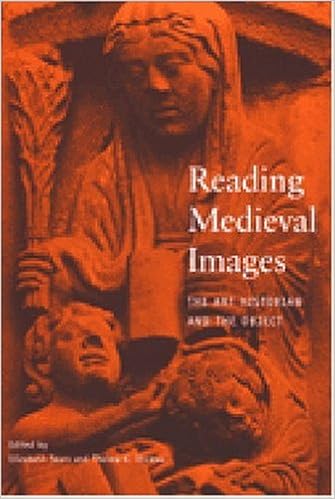Iconography, Symbols, Imagery
Encountering Medieval Textiles and Dress by ...costume history of fashion, textiles, and the representation of clothing in the middle ages.
Location: Mugar Library GT575 .E53 2002Illuminating Fashion : dress in the art of medieval France and the Netherlands, 1325-1515. by "Symbolism and metaphors are buried in the art of fashion" says Roger Wieck. At the heart of the work is A Pictorial History of Fashion, 1325 to 1515, an album of over 300 illustrations with commentary.
Location: Mugar Library Folio N8217.C63 B87 2011The Marvellous and the Monstrous in the Sculpture of Twelfth-Century Europe by Representations of monsters and the monstrous are common in medieval art and architecture, from the grotesques in the borders of illuminated manuscripts to the symbol of the "green man", widespread in churches and cathedrals... in what ways did monsters in twelfth-century sculpture help audiences envision, perhaps even achieve, various ambitions?
Location: Online and Mugar Library NB175 .A43 2013St Edmund, King and Martyr by St Edmund, king and martyr, supposedly killed by Danes (or "Vikings") in 869, was one of the pre-eminent saints of the middle ages; his cult was favoured and patronised by several English kings and spawned a rich array of visual, literary, musical and political artefacts.
Location: Online.The Tree by With its vital character - growing, flowering, extending its roots into the ground, and its branches and leaves to the sky - the tree is a polyvalent metaphor, a suggestive symbol, and an allegorical subject. During the Middle Ages, a number of iconographic schemata were based on the image and structure of the tree, including the Tree of Jesse and the Tree of Virtues and Vices.
Location: Mugar Library N8012.T74 T74 2014Reading Texts and Images : essays on medieval and Renaissance art and patronage in honour of Margaret M. Manion by This book is a collection of specially-commissioned art-historical essays on the theme of manuscript studies by some of the world's leading art historians and curators of manuscripts.
Location: Mugar Library ND2920 .R43 2002

Reading medieval images : the art historian and the object. Elizabeth Sears.
Location: Mugar Library N5975 .R425 2002.
The Icon: Holy Images, 6th to 14th Century. Kurt Weitzmann.
Location: Mugar Library Reserve Room N8187 .W44 1978.
Book of Beasts : the bestiary in the medieval world by A celebration of the visual contributions of the bestiary--one of the most popular types of illuminated books during the Middle Ages--and an exploration of its lasting legacy. Brimming with lively animals both real and fantastic, the bestiary was one of the great illuminated manuscript traditions of the Middle Ages. Encompassing imaginary creatures such as the unicorn, siren, and griffin; exotic beasts including the tiger, elephant, and ape; as well as animals native to Europe like the beaver, dog, and hedgehog, the bestiary is a vibrant testimony to the medieval understanding of animals and their role in the world. So iconic were the stories and images of the bestiary that its beasts essentially escaped from the pages, appearing in a wide variety of manuscripts and other objects, including tapestries, ivories, metalwork, and sculpture. With over 270 color illustrations and contributions by twenty-five leading scholars, this gorgeous volume explores the bestiary and its widespread influence on medieval art and culture as well as on modern and contemporary artists like Pablo Picasso and Damien Hirst. Published to accompany an exhibition on view at the J. Paul Getty Museum at the Getty Center May 14 to August 18, 2019.
Location: Mugar Stacks ND3339 .B66 2019
Suggested searches
- Medieval AND (image* OR imagery) all Material Types
- Medieval symbols all Material Types
- Medieval symbols filter: Books/ebooks
- Medieval iconography Advanced Search = medieval in title, iconography in title) All Material Types
- Art, Medieval - Themes, motives Browse by subject = Books only.
